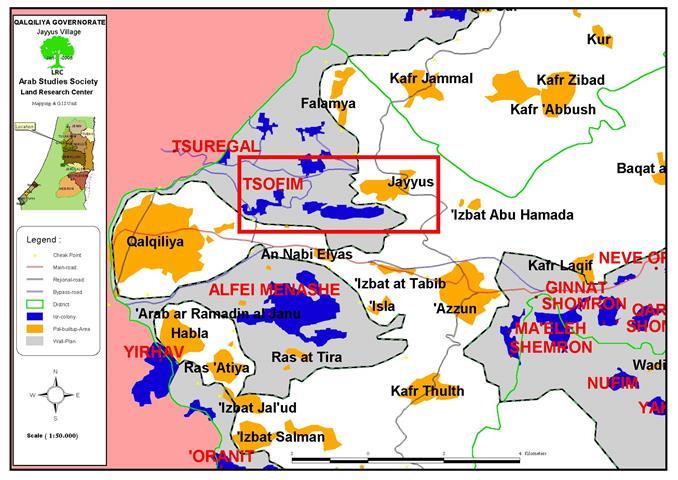Location, population and area:
The village of Jayyus is located to the north east of the city of Qalqiliya. It is adjacent to the green line and parts of its lands fall behind the green line.
Jauyys has the population of 3200 inhabitants mostly depending on agriculture and animal breeding as source of living after loosing their jobs inside Israel.
The lands of Jayyus is amongst the most fertile lands in the area. It's total area is 13045 dunums, of which 590 dunums are built up areas, 1500 cultivated with irrigated ground crops and citrus, 300 dunums of agricultural roads, as well as 10655 dunums of olive and almond trees. see map 1

map 1: location of Jayyus village
Jayyus and the Wall
About 70% of Jayyus lands have been segregated behind the Wall upon completion of Wall works about two years ago. Most of the irrigated and un-irrigated agricultural lands which form 90% of the village's general income were segregated behind the Wall. It is worth mentioning that The Wall was built at the depth of 6 km to the east of the green line over Jayyus lands leading to the total devastation of 600 dunums under it's path in addition to the uprooting and destruction of more than 4000 olive and almond trees.
Two Wall gates south and north – were introduced to allow a limited access to Palestinian farmers and land owners into their lands segregated behind the Wall. These two gates are opened on daily basis, except on Saturdays, but for very short periods. Only those who obtain proper land ownership documents are given passing permits from the Israeli military on condition that they should obtain security clearance from the Israeli intelligence. Because of this, more than 75 % of land owners and farmers of Jayyus are denied passing permits. This, in turn, has forced 80% of Jayyus people to depend on external food assistance programs.
New colonial nucleus
The settlement of Zufim was established in 1986 over 600 dunums of Jayyus lands. In the year 2003, it had the population of 1040 colonists (source- Foundation for Middle East Peace). It is located in Jayyus segregated lands.
Ever since the separation of Jayyus lands behind the Wall two years ago, Zufim colonists have been embarking on land confiscation and expansion activities. For example, 70 dunums located to the north of the settlement have been covered with caravans (mobile homes) at the end of last year.
In last November, another 30 dunums located 3 km to the north east of Zufim settlement have been leveled, provided with infrastructure and a road for the construction of a new colonial nucleus under the name of Zufim North expected to comprise 1200 housing units.
Further separation and strangulation
On April 7th, 2005, a military order was issued stipulating the confiscation of 8.6 dunum of land from the villages of Jayyus and neighboring Falamya. The purpose of this confiscation is to open a new 1250 meter long road between the village of Jayyus and Wall gate number 24 to the west of Falamya village to the north of Jayyus (See map 2) with the aim of referring the people of Jayyus â?? farmers and land owners- to this gate instead of Jayyus gate number 25 which will be completely closed at the beginning of next year, according to Israeli sources. See Map 2) with the aim of referring the people of Jayyus farmers and land owners- to this gate instead of Jayyus gate number 25 which will be completely closed at the beginning of next year, according to Israeli sources.

Map 2: The path of the new proposed agricultural road
This repressive measure will cause the following:
1. The family of Mr. Ali Musa whose house is segregated behind the Wall and currently using the nearby Wall gate of Jayyus number 25 will be forced to travel about 3 km each way to enter his village Jayyus. Given the fact that there are no proper roads to the west of the Wall linking between his house and Wall gate of Falamiya number 24, it means that his school children are obliged to walk every day the distance of 6 km to reach their schools in Jayyus, not to mention the need for medical care, shopping and other vital daily needs.
2. The opening of this alternative road will lead to the uprooting of hundreds of olive trees and inflict heavy damage to neighboring orchards and agricultural lands.
3. The people of Jayyus will be obliged to travel longer distances to reach their fields and by so doing spend more time and effort back and forth. In this regard, the Israeli authorities have notified the DCO offices in Tulkarem and Qalqiliya that all un- licensed tractors and agricultural machines will be barred from entering in to the lands segregated behind the Wall starting from January 1st, 2006. This new measure will add more pressure on the already destroyed Palestinian farmers as 90% of tractors and machines are un-licensed.
4. According to the new alternative road, the people of Jayyus will not have an easy access to their agricultural fields segregated behind the Wall once they crossed gate number 24 since they need to get proper sub roads on the other side of the Wall to bring them into to their fields.
5. Jayyus villagers are afraid that, eventually, they will loose their lands to the settlement as the Israeli laws stipulate that 'any lands abandoned for three years will become a state land'.
Prepared by
The Land Research Center
LRC














